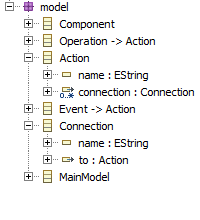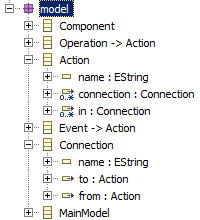Ecore
See also GMF.
I want to be able to go backwards through a reference
Also see Using EOpposite in GMF.
 If you have a model like the right, which only has a one-directional link, it’s not possible to find out what element the connection link came from. For example, if you have an Action A with a Connection to another Action B, you cannot ask the Connection of the source (Action A).
If you have a model like the right, which only has a one-directional link, it’s not possible to find out what element the connection link came from. For example, if you have an Action A with a Connection to another Action B, you cannot ask the Connection of the source (Action A).
The solution is to make the link bi-directional, by:
- Adding another reference attribute to each backwards reference so we can keep track of the back reference (“from” and “in” attributes)
- Setting the eOpposite reference to the opposite attribute, that is, the eOpposite of “from” is “connection”, and “to” is “in”.
Once you reload the .genmodel and re-create the model/edit code, you will now be able to go Connection.getFrom() and Action.getIn().
It will also change the generated model XML from:
<component name="Home Page">
<component name="Link to About Page">
<operation name="click">
<connection name="onClick" to="//@component.1/@operation.0"/>
</operation>
</component>
</component>
<component name="About Page">
<operation name="render"/>
</component>
 To:
To:
<component name="Home Page">
<component name="Link to About Page">
<operation name="click">
<connection name="onClick" to="//@component.1/@operation.0"/>
</operation>
</component>
</component>
<component name="About Page">
<operation name="render" in="//@component.0/@component.0/@operation.0/@connection.0" />
</component>
Adding comments to an EMF model
 The easiest way to do this is to add an EAnnotation like so:
The easiest way to do this is to add an EAnnotation like so:
- EAnnotation source: http://foo.com/comment
- DetailsEntry key: comment, details: (enter in your comment here)
EMF/GMF will ignore the EAnnotation and the comment will remain. Another option is to add it to the ecore_diagram visual editor as a note.